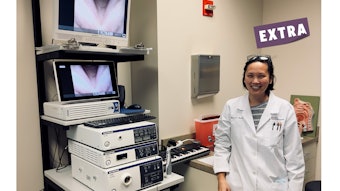Gamification and Serious Gaming in Otolaryngology Education
Aspects of gaming have been incorporated into surgical education. Learn about AAO-HNSF’s gaming xSIM module accessible through FLEX.
Katherine R. Kavanagh, MD, Chair, Simulation Education Committee,
Eric Gantwerker, MD, MSc, MS, member, Simulation Education Committee,
and Jeffrey P. Simons, MD, MMM, AAO-HNSF Coordinator, Education
Games date back thousands of years, and today are ubiquitous in our lives. It is estimated that more than three billion people and more than two-thirds of all Americans play games ranging from puzzles to mobile games to personal computer (PC) and console games. Video games are no longer relegated to children or adolescents in their basements as now more than three-fourths of game users are adults, with an average game player being 35 years old.1,2 It is highly likely that today’s medical students, trainees, and practicing otolaryngologists grew up playing games and may be active gamers.
Games are a big business, with revenues up in the $27 billion range, and it is not surprising that other industries are actively exploring how games can be used in advertising, marketing, and training.2 Gamification has been a term that has entered the public discussion and has evolved within education over the last 10 to 15 years.3,4 In a multimedia world, where attention and engagement are major pain points in education, it is no shock that games are being embraced by adult learners in medical, surgical, and corporate environments. Current adult learners are seeking education with engagement, immediate feedback, and interaction with other learners to enhance their experience and individual learning. When education activities are enjoyable, users are more likely to engage regularly and therefore increase their learning and retention.5
What Is Gamification? What Is Serious Gaming?
The term “gamification” refers to the incorporation of game elements into an experience, which can be anything from loyalty programs (e.g., Starbuck) and fitness programs (e.g., Peloton) to marketing and education.3,4 Game elements may consist of many things but often include points, leaderboards, interaction or competition with other participants (social mechanics), rewards, progression, puzzles, and challenges.3,4,5 Regardless of the individual elements, the unifying concept behind gamification is the idea that the game elements are intended to enhance the experience or change motivations.
“Serious games” is a closely related term but often refers to the purpose of the experience being something other than entertainment, most often education or some learning goal. Here the game elements are more seamlessly integrated into the experience that may involve a plot or story line embedded in a gaming platform and may have more elements of interactivity. These game elements are often intended to impart a learning objective on the players.3 Despite the distinctions between gamification and serious gaming, both are designed to increase motivation to learn and improve performance.5 Both gamification and serious gaming have been used successfully in otolaryngology education.
How Is Gamification Used in Surgical Education?
A variety of gaming aspects have been incorporated into surgical education, including question banks, leaderboards, rewards, progress through levels, and competition.3 Specific to otolaryngology, Alexander et al (2018) used an online question bank and employed gaming elements of immediate feedback, team competition, and earning badges to enhance learning for otolaryngology residents. Their results demonstrated an improvement in otolaryngology training examination (in-service) scores while using the gamified platform. Simple interventions such as JEOPARDY! have been shown to increase resident self-reported time spent reading6 and medical knowledge7. Research from corporate learning environments mirrors the increase in engagement and knowledge achieved through gamified education platforms.8 A recent study by the firm KPMG examined gamification in corporate learning and revealed improvement in performance, establishing that adult learners across disciplines are motivated by gamification in education.8
What Serious Gaming Opportunities Are Available through the AAO-HNSF?
The AAO-HNSF developed a serious gaming xSIM module accessible through FLEX9 with additional modules planned to include an upcoming collaboration with the Facial Plastic & Reconstructive Surgery Education Committee (FPRSEC) on a gaming module on facial fillers. As the interest in serious gaming grows within otolaryngology, the demand for high quality, engaging, and interactive education products is likely to increase. The AAO-HNSF is committed to developing more sophisticated education gaming applications as we move forward. It is likely that we will also see aspects of virtual reality or augmented reality incorporated into some of these modules as well as live gaming opportunities, such as escape rooms. Serious gaming is well suited to meet the education needs of physicians of all training levels from medical student to resident to practicing otolaryngologist.
References
- Saltzman, M. (2022, June 11). More adults play video games than kids – and more surprising stats. USA Today. https://www.usatoday.com/story/tech/gaming/2022/06/11/gaming-study-finds-adults-play-more-than-kids/7581101001
- Dimitrievski, M. (2023, February 25). Gaming Statistics - 2023 [web log]. Retrieved March 14, 2023, from https://truelist.co/blog/gaming-statistics/.
- Westenhaver ZK, Africa RE, Zimmerer RE, McKinnon BJ. Gamification in otolaryngology: A narrative review. Laryngoscope Investig Otolaryngol. 2021 Nov 29;7(1):291-298. doi: 10.1002/lio2.707. PMID: 35155810; PMCID: PMC8823161.
- Alexander D, Thrasher M, Hughley B, Woodworth BA, Carroll W, Willig JH, Cho DY. Gamification as a tool for resident education in otolaryngology: A pilot study. Laryngoscope. 2019 Feb;129(2):358-361. doi: 10.1002/lary.27286. Epub 2018 Nov 13. PMID: 30421431.
- Looyestyn J, Kernot J, Boshoff K, Ryan J, Edney S, Maher C. Does gamification increase engagement with online programs? A systematic review. PLoS One. 2017 Mar 31;12(3):e0173403. doi: 10.1371/journal.pone.0173403. PMID: 28362821; PMCID: PMC5376078.
- D'Alessandro DM, Ellsbury DL, Kreiter CD, Starner T. Pediatric jeopardy may increase residents' medical reading. Ambul Pediatr. 2002 Jan-Feb;2(1):1-3. doi: 10.1367/1539-4409(2002)002<0001:pjmirm>2.0.co;2. PMID: 11888428.
- Webb TP, Simpson D, Denson S, Duthie E Jr. Gaming used as an informal instructional technique: effects on learner knowledge and satisfaction. J Surg Educ. 2012 May-Jun;69(3):330-4. doi: 10.1016/j.jsurg.2011.10.002. Epub 2011 Nov 15. PMID: 22483133.
- Cullen, J. (2023). Does Gamified Training Get Results? Harvard Business Review. Retrieved March 14, 2023, from https://hbr.org/2023/03/does-gamified-training-get-results#:~:text=But%20a%20new%20study%20shows,can%20significantly%20improve%20employee%20performance.
- 9. Simons, J. P., & Osborne, K. M. (2021, August). Online Simulation and Gamification. Bulletin, 40(7). Retrieved March 14, 2023, from https://bulletin.entnet.org/aao-hnsf-2021/article/21590421/online-simulation-and-gamification.


















